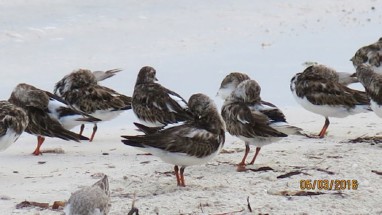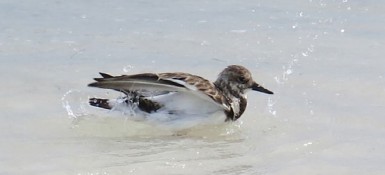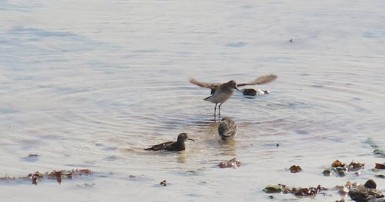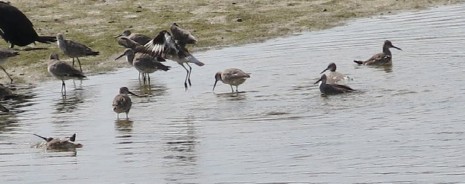William E. Davis, Jr.
On February 21 and 28, and March 5 and 17, 2016, I watched flocks of shorebirds on the beaches of the Florida Keys and Sanibel Island in western Florida. I paid particular attention to the behaviors of these shorebirds as they foraged, interacted aggressively, bathed, and preened; and I recorded my observations in my journal. The flocks that I watched on the first three days were composed of Ruddy Turnstones (Arenaria interpres), Sanderlings (Calidris alba), and Least Sandpipers (Calidris minutilla). The flock on March 17 was composed of Willets (Tringa semipalmata). I discuss below several of the behaviors I witnessed. Previously, I have reported on foraging and aggressive behavior by these same species at the same localities (Davis 2003, 2008, 2011, Davis and Jackson 2007).
Maintenance Behaviors
The social or group aspects of two maintenance behaviors, bathing and preening, were of particular interest. In each of my four separate observations of bathing—including one on Geiger Beach near Key West in 2014—more than one individual was bathing. In the one instance when a single Sanderling and Least Sandpiper bathed they were in the company of four bathing Ruddy Turnstones. Although individual preening birds were often scattered throughout roosting flocks, there were also times when all of the birds in a section of the flock were actively preening (Figure 1). These observations suggest that social stimulation may be involved in bathing and preening behaviors.
The February 21 and March 5 observations were presumably of the same flock of more than 50 individuals on the same beach at Bahia Honda State Park in the Florida Keys. Total observation time was about three hours in mid-afternoon. On February 21, I photographed one of two turnstones as it bathed (Figure 2). It would typically duck its head under water, then toss its head up and shake while fluttering its wings and body feathers. It drooped its wings and ended the bathing with preening. On March 5, I recorded seven turnstones bathing (four at one time), with one Least Sandpiper and one Sanderling bathing with the four bathing turnstones. On March 4, 2014, I watched Least Sandpipers bathing together at Geiger Beach. I recorded the event as:
Least Sandpipers, three together in shallow water of Atlantic side, bathing: dip head under water, bring it up and flutter-flap wings and tail down on water, in bouts of about 1 second (Figure 3). Then two birds together 1–2 feet from shore, 10–12 shakes, fly up with rapid flapping (presumably to dry themselves) then land and run ashore. About eight birds bathing in 11 minutes of observation. About 60 birds in flock.
All the bathing occurred in one section of the flock. On March 17, I encountered a flock of Willets at a beach in Ding Darling National Wildlife Refuge. Most were loafing but at one end of the flock I watched a group of five Willets bathing (Figure 4). I wrote:
… at one point there was a flock of more than 150 Willets and I photographed five of them, as a group, bathing—why do small groups do this rather than random individuals? This is similar to the behavior I have observed in both Least Sandpipers and Ruddy Turnstones.
I searched the Birds of North America species accounts of these four species and found bathing described only for the Least Sandpiper (Cooper 1994) and for Ruddy Turnstones (Nettleship 2000). Bathing was not mentioned in the Sanderling account (Macwhirter et al. 2002), and the Willet account showed a simple “No information” under the section “Preening, head-scratching, stretching, bathing, anting, etc.” (Lowther et al. 2001). In none of the accounts was the social nature of bathing mentioned.

Fig. 1: A cluster of Ruddy Turnstones preening. All photographs by the author.

Fig. 2. A bathing Ruddy Turnstone shaking its head as it emerges from a dunking.

Fig. 3. Three bathing Least Sandpipers, including one with wings spread and shaking off water.

Fig. 4. Four bathing Willets with a fifth that has flown and is shaking off water.
Intraspecific Kleptoparasitism
Kleptoparasitism, the stealing of food by one individual from another, is common among some birds—e.g., gulls, jaegers, and frigatebirds—but is rare among the Passeriformes. It has been reported for many species of shorebirds. On February 28, 2016, I witnessed an act of intraspecific kleptoparasitism among Ruddy Turnstones at Veterans Memorial Park in the Florida Keys, and I noted numerous similar cases on March 5, at Bahia Honda State Park.
On February 28, at 3:45 pm, I watched a Ruddy Turnstone pick up what looked like a flat three-quarter-inch diameter sea bean, possibly a coin vine (Dalburgia sp.). It dashed off and was pursued by three other turnstones, each of which made close passes at the first bird over perhaps 50 feet. One of the pursuing birds finally grabbed the sea bean from the first bird and fled with it—a clear case of intraspecific kleptoparasitism. On March 5, in a flock of 30 or more Ruddy Turnstones, individuals were finding yellow food items between one and two centimeters in diameter and mostly flat. When a bird ran by holding one of these items in its beak it caused a veritable frenzy of intraspecific kleptoparasitism behavior from the other turnstones. As one bird ran back and forth through the other sandpipers, I counted 29 attempts to steal the food—probably some birds attacked on more than one occasion—before the flock was spooked and flew off. I witnessed similar behavior on at least six occasions. In several of these situations the food item was broken and multiple turnstones attempted to retrieve the fragments. Although Least Sandpipers and Sanderlings were present in the shorebird flock on March 5, I observed kleptoparasitism only among the turnstones.
In searching the Birds of North America species accounts of the four species mentioned above and other literature, I found that the Willets had been observed stealing food from Long-billed Curlews (Numenius americanus) (Lowther et al. 2001) and from a White Ibis (Eudocimus albus) (Davis and Jackson 2007) which were cases of interspecific kleptoparasitism. For Sanderlings, it had been reported that Sanderlings may fight over large prey items, implying kleptoparasitism behavior (Macwhirter et al. 2002). I could not find any reference to kleptoparasitism in the Ruddy Turnstone account (Nettleship 2000) or in the Least Sandpiper account (Cooper 1994). There is some evidence that in shorebirds kleptoparasitism occurs more frequently at high feeding densities and is more likely when food items are large and require long handling times (Colwell 2010). It has also been suggested that larger prey may be less accessible to shorebirds because they may attract the attention of other shorebirds (Geering et al. 2007). I suspect that intraspecific kleptoparasitism in Ruddy Turnstones is a fairly common behavior but that it is underreported.
Literature Cited
- Colwell, M. A. 2010. Shorebird ecology, conservation, and management. Berkeley: University of California Press.
- Cooper, J. M. 1994. Least Sandpiper (Calidris minutilla). in The Birds of North America, No. 115 (A. Poole and F. Gill, Eds.). Philadelphia: The Academy of Natural Sciences; Washington D.C.: The American Ornithologists’ Union.
- Davis, W. E., Jr. 2003. Commensal foraging and a “beater effect” involving Ruddy Turnstones, Sanderlings, Least Sandpipers, and Short-billed Dowitchers. Florida Field Naturalist 31: 59-61.
- Davis, W. E., Jr. 2008. Aggressive behavior and territoriality among wintering mixed-species sandpiper foraging flocks on the Florida Keys. Bird Observer 36: 219-222.
- Davis, W. E., Jr. 2011. Ruddy Turnstones and a Sanderling drink fresh water. Bird Observer 39: 95-96.
- Davis, W. E., Jr., and J. A. Jackson. 2007. Willets kleptoparasitize and use White Ibis as “beaters.” Wilson Journal of Ornithology 119: 758-760.
- Geering, A., L. Agnew, and S. Harding. 2007. Shorebirds of Australia. Collingwood, Victoria, Australia: CSIRO Publishing.
- Lowther, P. E., H. D. Douglas III, and C. L. Gratto-Trevor. 2001. Willet (Catoptrophorus semipalmata). in The Birds of North America, No. 579 (A. Poole and F. Gill, Eds.). Philadelphia: The Academy of Natural Sciences; Washington D.C.: The American Ornithologists’ Union.
- Macwhirter, B., P. Austin-Smith Jr., and D. Kroodsma. 2002. Sanderling (Calidris alba). in The Birds of North America, No. 653 (A. Poole and F. Gill, Eds.). Philadelphia: The Academy of Natural Sciences; Washington D.C.: The American Ornithologists’ Union.
- Nettleship, D. 2000. Ruddy Turnstone (Arenaria interpres). in The Birds of North America, No. 537 (A. Poole and F. Gill, Eds.). Philadelphia: The Academy of Natural Sciences; Washington D.C.: The American Ornithologists’ Union.
